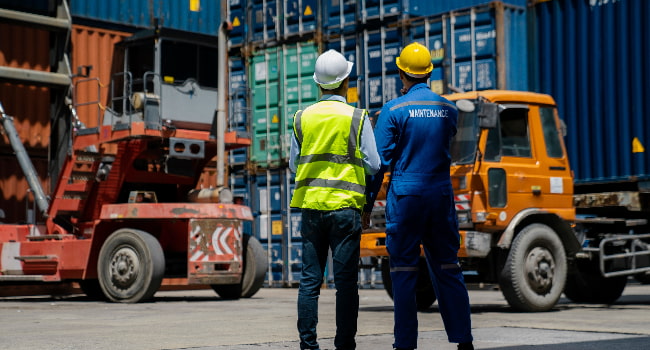A1 Quality Logistical Solutions

- By Haley
- January 14, 2025
Table of Contents
Key Highlights
- Lumper services play a crucial role in ensuring efficient loading and unloading of goods within the supply chain, ultimately impacting customer satisfaction.
- Challenges such as billing discrepancies, unloading delays, and compliance concerns can disrupt logistics operations and lead to financial losses.
- Implementing effective communication channels between shippers, carriers, and lumper service providers is essential for addressing challenges promptly.
- Technology plays a pivotal role in enhancing lumper accountability and streamlining operations, leading to improved efficiency and transparency.
- A strategic approach to managing lumper services involves establishing clear contracts, implementing robust training, and leveraging technology for optimized outcomes.
Introduction
Lumper services connect transportation and warehouse operations. Managing lumper services helps improve logistics operations and provide a great customer experience. This blog post will talk about the common issues businesses face with lumper services and provide helpful solutions to fix them.
Understanding Lumper Services in the Logistics Industry
The logistics industry depends on various connected processes. These processes help move goods from the starting point to the end point smoothly. Lumper services work mainly out of sight but are very important. They help keep everything running well, especially in warehouses.
These services provide skilled workers to load and unload cargo from trucks and trailers. This job is hard and needs to be done quickly. It is key to efficient warehouse operations. By using these services, businesses can make the best use of their internal staff. This allows them to concentrate on what they do best.

Defining Lumper Services and Their Role in Freight Handling
Lumper services help connect shippers or freight forwarders with workers who handle goods in a warehouse or distribution center. When a truck gets to a warehouse, lumper teams quickly unload the cargo. They make sure goods are handled carefully and stacked correctly.
One of the main benefits of lumper services is that they reduce shipping costs and avoid delays during unloading. By using expert teams, businesses don’t need to shift their own workers or bring in and train temporary staff. This makes the unloading quicker.
This speed helps businesses save money over time. Trucks spend less time waiting at the dock. This improves overall supply chain operations.
The Importance of Lumpers in the Supply Chain
Lumpers play a crucial role in the supply chain. They help make logistics services run smoothly and efficiently. Their skills in loading and unloading goods keep things moving on time. This helps avoid delays that can affect the entire supply chain.
Lumpers also have useful knowledge about warehouse layouts, how to handle products, and safety rules needed for a warehouse management system. This understanding speeds up unloading and reduces the chance of damage to the goods.
In short, lumpers are like an extra part of a company’s logistics team. They help make sure the movement of goods between transportation and storage happens without problems. This support is vital for the success of supply chain operations.
Common Challenges Associated with Lumper Services
While lumper services have clear benefits, they can also lead to some challenges. These issues may affect efficiency, costs, and compliance. It is important to know about these potential problems so we can create good ways to fix them.
This section will look at the common challenges businesses face when using lumper services. This includes issues with billing and payments, as well as safety and compliance problems in warehouse operations.

Navigating Billing and Payment Discrepancies
Disputes about billing and payments often happen with lumper services. This can occur because of unclear billing practices, misunderstandings about what services are included, and mistakes during payment processing. These issues can lead to delays and harm the relationship between businesses and service providers.
To reduce these problems, companies should focus on:
- Clear Communication: Talk openly with the lumper service provider from the start. Make sure you explain the services included and the billing terms clearly.
- Detailed Contracts: Use detailed contracts that outline the work, hourly rates, extra fees, and payment terms to prevent confusion.
- Timely Invoice Reconciliation: Check invoices against work orders regularly. This helps to spot and fix differences quickly, ensuring that payments are processed accurately.
Dealing with Inefficiency and Delays in Unloading
Inefficiency and delays when unloading can hurt warehouse operations. They can mess up transportation schedules and affect how orders are fulfilled. Some reasons for these delays are not enough staff, not enough equipment, or poor teamwork between the lumper team and warehouse workers.
To fix these issues, businesses should think about:
- Performance Monitoring: Setting up systems to watch how the lumper team works. This helps to track unloading times and find areas that need fixing.
- Optimal Scheduling: Using better scheduling tools to match when the lumper is available with truck arrival times. This will cut down on waiting time and make sure the workforce is used well.
- Open Communication: Encouraging clear communication between lumper teams, truck drivers, and warehouse staff. This helps with smooth coordination and solving problems quickly.
Compliance and Safety Concerns in Warehouse Operations
Making sure we follow labor laws and keep safety standards high is very important for warehouse operations. Lumper services have specific rules about worker safety, how much they get paid, and insurance. If businesses do not follow these rules, they could face legal problems and harm their reputation.
To reduce risks with compliance and safety, companies should:
- Vetting Lumper Services: Check potential lumper service providers closely. Make sure they have insurance, a good safety record, and follow labor laws.
- Enforcing Safety Protocols: Set up and enforce strong safety rules in the warehouse. Make sure lumper teams are well trained and have the right safety gear.
- Regular Audits: Check lumper service providers regularly to ensure they follow safety rules and company standards. Take action if needed.
Strategies for Overcoming Lumper Service Challenges
To tackle the issues with lumper services, we need to use different methods that focus on clear communication, honesty, and smart use of technology.
By acting on useful strategies, businesses can build better and more helpful partnerships with lumper service providers. This can help improve their supply chain operations and make everything run more smoothly.

Implementing Effective Communication Channels
Open and clear communication among everyone involved, from the shipper to the lumper, is very important. It helps reduce problems and leads to successful logistics operations. Good communication builds trust and allows quick solutions for any issues that come up.
Putting money into communication methods that make sharing information easier is essential. This can mean having main points of contact, using shared online tools for tracking orders and updates, and doing regular reviews to fix any problems early on.
When companies focus on clear and steady communication, they can create better relationships with lumper service providers. This leads to smoother operations and improves customer satisfaction.
Enhancing Lumper Accountability through Technology
Technology can really help improve how we track lumpers and make warehouse work easier. When we use warehouse management software together with lumper service platforms, we can see important information right away. This includes arrival times, unloading times, and any possible delays.
Having this data helps us make better choices, check how well we are doing, and find where we can do better. Automated systems can also keep an eye on work hours to make sure billing is correct and to reduce any disagreements.
By using technology, businesses can create more openness and responsibility in their lumper work. This helps them make smart choices to work better and avoid costly mistakes.
Streamlining Operations with Advanced Scheduling Tools
Advanced scheduling tools can revolutionize how logistics providers manage their lumper workforce, leading to significant improvements in efficiency and reduced operational hiccups. These tools can optimize lumper allocation based on anticipated workload, truck arrival times, and specific loading/unloading requirements.
For example:
Scheduling Tool Feature | Benefit to Lumper Operations |
Real-Time Truck Tracking | Anticipate arrivals and allocate lumpers proactively |
Automated Lumper Assignment | Match lumper skills to specific job requirements |
Demand Forecasting | Optimize staffing levels based on anticipated workload |
By adopting these advanced scheduling tools, logistics providers can minimize wait times for drivers, reduce overtime costs, and ensure that the right resources are available at the right time, significantly boosting overall operational efficiency.
The Financial Implications of Lumper Services
Using lumper services has many benefits for operations. However, it is important for businesses to understand the costs involved. This helps them make better choices. They need to compare the costs of hiring lumpers with the savings they can get. It is also key to look at how using these services affects their profits.
This section will look into the money side of using lumper services. It will check the cost vs. benefits and highlight any hidden costs that businesses should know about.

Analyzing the Cost-Benefit Ratio of Hiring Lumpers
A detailed cost-benefit analysis is used to decide if you should add lumper services to your supply chain management. Lumper fees are direct costs. However, you should compare them with the savings and extra efficiency you can gain by using these services.
Using lumper services can help lower detention charges. These charges occur when trucks take too long to unload, especially during busy times or when there are more orders than usual. Also, hiring outside lumper services saves your business money because you don’t have to pay for the costs of training and hiring temporary workers. This also helps you manage labor costs better.
Additionally, trained lumper teams work quickly and carefully, which reduces the chance of damaging products while they unload. This could lead to significant savings by avoiding losses from damaged goods.
Hidden Costs in Lumper Services and How to Avoid Them
Lumper fees are clear costs, but you should also be aware of possible hidden costs that can affect your budget. Delays caused by slow lumper teams can create problems for your inventory management and distribution services.
Charges for truck detention, fees for storing delayed inventory, and costs for fast shipping to meet order deadlines can quickly eat up any savings you thought you had with lumper services. To avoid these hidden costs, it is important to pick good lumper service providers who are reliable and efficient.
Doing your homework, asking for references, and choosing clear billing methods can help reduce the chances of unexpected costs. This will help keep your budget safe.
Best Practices in Managing Lumper Services
Strategic management of lumper services reduces risks or problems and helps to set clear expectations from the start. It’s crucial to follow safety rules and use technology to make things more open and manageable.
By using the best practices, businesses can build better relationships with lumper service providers. This can lead to smoother operations, saving money, and better customer satisfaction.

Establishing Clear Contracts and Expectations
A clear contract is key for a good partnership with a lumper service provider. The contract should explain the services clearly. It needs to include who is responsible for loading and unloading, how to handle specific products, and what is expected in terms of performance.
Service level agreements (SLAs) are important too. They lay out acceptable turnaround times, explain how to deal with delays, and show the steps to handle damaged goods. By being clear from the start, both sides can agree on service delivery. This helps reduce misunderstandings or disputes when handling customer orders.
Detailed contracts also offer legal safety and are a helpful guide during the business relationship. This creates a clear and beneficial partnership for everyone involved.
Training and Safety Protocols to Ensure Compliance
- Training for lumper services is very important.
- Lumper teams need to learn how to load and unload correctly.
- They should know how to use equipment safely and handle hazardous materials.
- Regular safety meetings and supervision are key.
- This helps everyone follow safe work methods and meet industry rules.
- Companies must provide a safe workplace.
- This includes having good equipment, enough lighting, and clear paths in the warehouse.
- By focusing on training and building a strong safety culture, companies can reduce the chance of accidents and injuries.
- This protects workers and helps maintain a good reputation.
Leveraging Technology for Better Lumper Management
Integrating technology into managing lumpers has many advantages. It can lead to more efficiency, clear processes, and smart decision-making based on data. You can use warehouse management software to check how lumpers are doing. It helps monitor loading and unloading times and find problems in the process.
Having real-time data helps businesses make better layouts for warehouses, use resources wisely, and keep orders on time. Using mobile devices for talking and managing tasks makes work easier. This cuts down on mistakes and helps truck drivers, lumper teams, and warehouse staff work together better.
When businesses accept technology, they can see more clearly into lumper work. They can find what needs to improve, boost productivity, and create a smoother and cheaper supply chain.
Case Studies: Success Stories in Managing Lumper Services
Real-world examples can help us understand how businesses have solved problems and benefited from good lumper service management. Looking at these case studies teaches us about successful strategies and the real results we can get from best practices.
This part focuses on real-world stories of companies that have greatly improved lumper efficiency. They have done this by using smart planning and new ideas to overcome usual challenges.

How Technology Revolutionized Lumper Efficiency for a Leading Retailer
A big national retailer had issues with lumper efficiency and increasing labor costs. To solve this, they decided to use technology to improve their warehouse operations. They set up a cloud-based warehouse management system that connects with a lumper management platform. This setup gave the retailer real-time insight into their lumper workforce.
This new technology let them see when lumpers arrived, how long each team took to load and unload, and where the delays were in their distribution centers. The system made automatic reports showing performance trends. This helped the retailer make smart decisions about scheduling and using lumpers better.
Because of these changes, they reduced the time trucks spent waiting, improved their delivery times, and saved money by using lumpers more efficiently and cutting down detention charges. This use of technology showed how retailers can change the game by enhancing their lumper operations and boosting efficiency in their warehouse operations.
A Logistics Company’s Journey to Overcoming Lumper Service Challenges
A fast-growing logistics company faced many customer complaints about the uneven quality of their lumper service. They realized they needed to tackle these issues head-on. So, they created a plan focused on communication, transparency, and accountability.
The company set up a system to evaluate the performance of lumper teams. They offered regular feedback and rewards for those who did a great job. They also made it easy to communicate between shippers, carriers, lumper service providers, and their customer support team. This helped provide timely updates and solve problems quickly.
By focusing on clear communication and openness, the company built better relationships with lumper providers. This led to a big boost in service quality and customer satisfaction. Their proactive method showed how important good communication and teamwork are in overcoming lumper service problems and achieving long-term success.
Future Trends in Lumper Services
The lumper service industry is about to see big changes because of new technology and the need for better efficiency in logistics. As companies work hard to automate more, use data analysis, and gain real-time insight, technology will play a larger role in lumper services.
This section looks at new trends that will change how lumper services work. It shows the innovations that are ready to transform how businesses handle their loading and unloading tasks.

The Role of Automation and AI in Streamlining Lumper Operations
Automation and artificial intelligence (AI) could change how lumper services operate by improving logistics operations and efficiency. Robotic process automation (RPA) can take care of repetitive tasks like scheduling, dispatching, and processing invoices. This allows human workers to focus on more complicated tasks.
Predictive analytics, which uses AI, can predict the demand for lumpers. It does this by looking at past data, seasonal trends, and current order volumes. This helps companies plan their staffing needs and manage their resources better. AI vision systems can also scan cargo, identify items, and check for damage automatically. This cuts down on mistakes and speeds up the loading and unloading process.
When lumper service providers use these new technologies, they can work faster, lower costs, and provide better service. All of this adds more value for their clients.
Predictions for Lumper Services in the Next Decade
Over the next ten years, the lumper service will move from relying mostly on manual labor to using more technology. As supply chains focus more on speed, efficiency, and transparency, lumper services need to adapt to stay ahead. We can expect to see on-demand lumper platforms. These platforms will link businesses with trusted lumper teams in real-time, similar to how gig economy apps are changing other fields.
Also, adding blockchain technology to lumper service platforms can make things clearer, safer, and more trustworthy. Blockchain can help with secure payments, keep accurate records of all transactions, and manage contracts better. This will create more accountability and trust between everyone involved.
In the future, lumper services will mix technology with human skills. Businesses will use new tools and smart strategies to improve their loading and unloading. This is all aimed at gaining maximum efficiency and a better customer satisfaction experience.
Conclusion
In conclusion, it is important to understand and manage lumper services in the logistics industry. This helps to improve supply chain operations. Companies can face challenges like billing issues, slow unloading, and safety problems. Better communication, using technology, and smoother operations can help solve these issues. This will lead to higher efficiency and profits. Following best practices, such as having clear contracts and safety rules, will also improve how they manage lumper services. As the industry incorporates automation and AI, it is vital to keep up with new trends. By embracing these changes, businesses can overcome challenges and explore new chances in lumper services.
Frequently Asked Questions
What are the most effective ways to resolve disputes with lumper services?
Open communication is very important for solving disputes. Make sure to write down all the talks you have with the service provider. If you find any issues, talk to the customer service department of the lumper service right away. Keep copies of contracts, work orders, and invoices nearby to refer to them as needed.
How can small businesses afford lumper services without compromising their budget?
Small businesses can look for cheaper options. They can talk about fixed prices for services they use often. They can also team up with other businesses to split lumper fees. It’s important to check that the lumper service providers work well with your budget and needs.
Are there any regulatory changes expected to impact lumper services soon?
- It is very important to know about any changes in rules that affect lumper services.
- You can do this by subscribing to industry magazines.
- Talk to legal experts and join groups that are relevant.
- This helps you stay updated on new legal needs and follow the rules.
What technologies are currently shaping the future of lumper services?
Emerging technologies such as warehouse management systems, automation, and AI are changing how lumper services work. These new tools help us see everything happening in real-time. They also improve how we use our workforce and make our processes simpler to boost efficiency.
How can companies ensure compliance and safety when using lumper services?
It is important to carefully check lumper service providers. This includes making sure they have insurance and good safety records. You should also create thorough training programs on safe warehouse operations. Finally, it’s crucial to follow and enforce safety rules in your facility.
How can improper lumper services impact a company's operations?
Improper lumper services can cause shipment delays. They can also lead to damaged goods and higher costs. This severely affects customer experience. Additionally, it can disrupt the supply chain and harm the brand’s reputation.

Haley serves as the Marketing Manager for A1 Quality Logistical Solutions. She joined A1QLS in 2023 with her prior experience gained with GXO and XPO Logistics.
